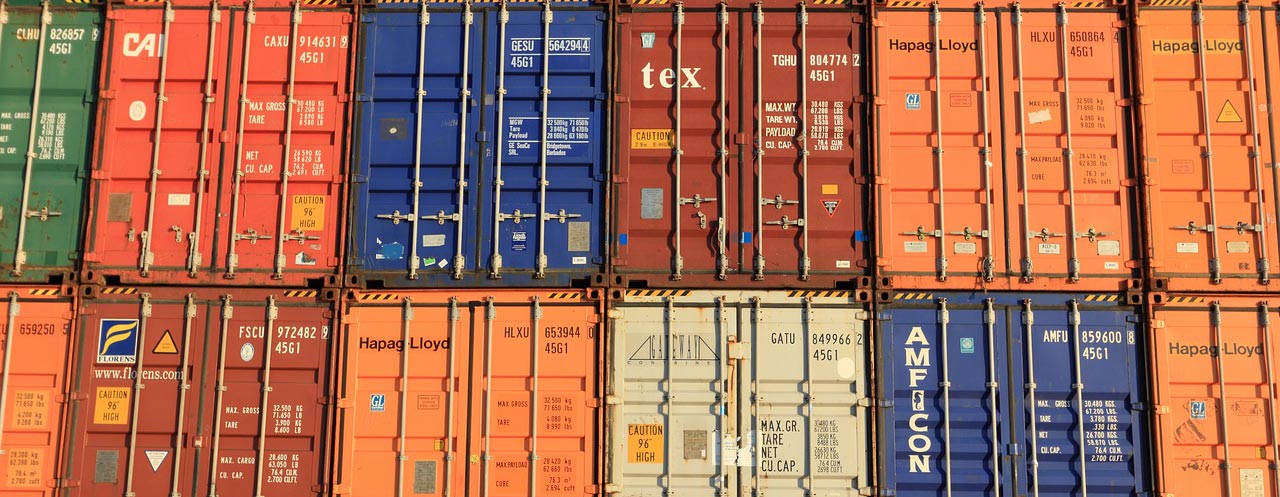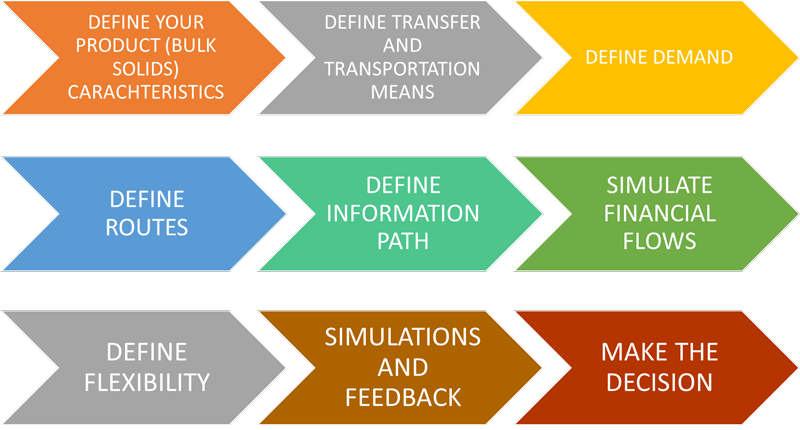Continued from the previous article: Timeline and scope for a bulk handling project
A supply chain is composed by:
This discussion about the scope of work for the supply chain and timeline for decision-making in bulk handling projects is clearly related to the physical flow portion of the supply chain. This is affected by the financial and information flows, too. In short, the scope of work in the supply chain to transport bulk in containers could be:
-
- Define / collect material to be processed: data, sources and uses.
- Define current position in the supply chain:
- Are you moving raw materials from prospection mines to first industrialization (as with ores, seeds, crops, minerals, etc.)?
- Are you moving from a plant that processes some raw material and provides some dry bulk solids for other industrialization steps?
This makes a big difference because of the type of storage, conveyors, transfers, etc.
- Define demand and locations to designate transfer volumes and routes:
- For the type of transportation to use: containers with liner bags, bulk truck tanks, bulk carrier ships, special cargo transport, transport bulk in containers, etc.
- To help establish the number of transport units needed over a period of time.
- To assign routes, times on route, and how much material will be in transit, affecting the total storage numbers.
- Specify load – unload methods for each process and transport mode.
- Define goals:
- Timeframe
- Money (investment X expenditures)
- Adaptability
The only way to compare methods is comparing them against certain goals through real data or simulations.
Hau L. Lee
U.S. Professor of Operations, Information and Technology at Harvard Business Review
With this definition, the supply chain manager can start the project to achieve a lower cost for the operation.
First things first
For a good bulk handling project, first imagine and define what the last thing will be:
“START WITH THE END IN MIND.”
Both statements were used by Stephen Covey in his book “7 Habits of Highly Efficient People” to express that some concepts are applicable in many fields, including our personal lives.
The physical flows
Defining where and for what the product will be used is a necessary step in this timeline description because both affect the transport, storage, and so on.
By having the end in mind, the supply chain management can define how the materials should flow through the chain, model the transportation and transshipment problems related to facility locations and network. Then management can plan ahead, simulate and anticipate some potential troubles with the supply chain, solve the problem by finding the balance between costs and level of services, including in this balance the simulations regarding the need for flexibility.
After the actions described above, the SCM can conduct a sensitivity analysis of each possible solution, using an optimization tool or a real-world network result analysis.
And the financial flows?
Surely, the financial flows are what drive the whole process and the most important ones are affected by:
- Inventory levels by type (raw, work-in-progress, process storage, etc.)
- Facilities to be fed: types of equipment, type of material fed, and labor
- Material Insourcing vs. outsourcing
- Operation shown in numbers: results, income statements (profit & loss), balance sheets (assets & liabilities), and cash flows (sources and uses of cash).
These lead the SCM to analyze the activity based costing / working capital (cash-to-cash cycle) and the discounted cash flow analysis.
The financial flows provide feedback to the physical flows that lets the SCM group decide physical procedures to transport bulk in containers while in the simulation mode or to decide changes when in the real-world mode.
The information flows
This is a very simple summary of what is expected on the information flow side of the problem.
While purchasing plays an essential role on the source side, nothing can be done without the feedback from delivery (or sales and operations). This, in the end, relies on collaboration.
The Port of Houston is working on an automated approach to reduce the cargo owners and the logistics partners to decrease the time spent to manually search the availability information. This will allow for better planning for the containers’ use, shipment planning and operation, by sharing information about containerized cargo moving through the supply chain in real-time.

From the magazine PETROCHEMICAL UPDATE, Nov. 16, 2017 issue, in the “US Gulf develops automated systems to improve container availability” article by Heather Doyle we find that
All Port of Houston facilities have handled 28.8 million tons of cargo year-to-date as of September, a 9% percent increase over the first three quarters of 2016. Container volume alone recorded an 11% increase versus last year, and in September surpassed the 1.8 million twenty-foot equivalent unit mark.
This means that the time spent on waiting for containers to be moved and transferred is reduced, and so is the total cost for trucks, cranes, etc., saving energy, space and time.
How should the timeline look like?
The following is a simple graphic representation of what is proposed in the last two articles:

What’s left to say?
Although each person may have their own decision-making method, when talking about import and export shipment planning and operations, the best way to move dry bulk solids is to use containers with container liner bags. The exception would be if the volumes and frequency are large enough to justify the empty return of the bulk cargo truck tanks, special cargo transport, or bulk cargo carrier ships or if they are too small to justify the use of alternative methods (i.e.: dump trucks).
This helps the decision maker while studying the physical flows to reduce the number of options and time spent on simulations between different transportation modes.
